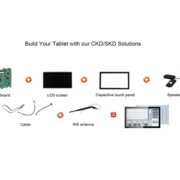CKD and SKD Models for Smart Home Panels and Industrial Tablets
In global B2B trade, CKD stands for Completely Knocked Down. This means a product is shipped in its fully disassembled state, down to the smallest screws and connectors. The parts are then assembled locally in the destination country.
Why choose CKD?
- Optimized shipping costs – Because products are shipped in parts, more units fit into one container. This can reduce freight costs by up to 30% compared to fully assembled products.
- Lower import tariffs – Many countries apply lower duties on components than on finished goods, sometimes reducing tariffs by 10–20%.
- Customization flexibility – Local assembly allows partners to adapt products to meet market preferences, whether it’s branding, interface design, or hardware adjustments.
At Portworld, CKD is especially popular with partners who have strong assembly capabilities and want to reduce costs while gaining flexibility. For example, our smart home touch panels and PCBA boards are often shipped in CKD form to Europe and North America, where partners customize features and finish assembly locally.
What Is SKD in B2B?
SKD means Semi-Knocked Down. Products are partially assembled at the factory, with major sub-assemblies pre-built, and final assembly done at the destination.
Why choose SKD?
- Balance of efficiency and cost – While not as space-efficient as CKD, SKD still reduces freight costs compared to shipping fully assembled units.
- Faster time to market – Since only final assembly is needed, products reach shelves quicker.
- Simpler assembly – SKD requires less technical expertise than CKD, making it ideal for partners with smaller assembly lines or limited labor resources.
For instance, our YC-SM series smart home panels or industrial embedded tablets can be delivered in SKD format, with the mainboards and displays pre-assembled, while final casing and branding are completed locally.
CKD vs. SKD: Key Differences
| Factor | CKD (Completely Knocked Down) | SKD (Semi-Knocked Down) |
|---|---|---|
| Level of Disassembly | Fully disassembled, every part separate | Partially assembled, major modules pre-built |
| Shipping Costs | Maximum savings, most space-efficient | Moderate savings |
| Assembly Complexity | High – requires skilled labor & tools | Lower – simpler local assembly |
| Import Tariffs | Often qualifies for lower duties | May qualify, but usually less than CKD |
| Time to Market | Slower due to full assembly needs | Faster, quicker market entry |
| Customization | Maximum flexibility | Limited customization |
| Labor Costs | Higher, requires more manpower | Lower, less labor-intensive |
When to Choose CKD in B2B
- You want to maximize cost savings on shipping and tariffs.
- You have strong assembly capabilities and technical expertise.
- You need high customization for local markets.
- You are importing into markets with high tariffs on finished goods.
Example: A European smart home integrator imports Portworld RK3566/RK3568-based PCBA boards in CKD form, assembling them into customized control panels with local branding.
When to Choose SKD in B2B
- You need a faster time to market.
- You have limited local assembly facilities.
- You want a balance between cost savings and efficiency.
- You still want basic customization options like branding.
Example: A Middle Eastern distributor receives Portworld smart home wall panels in SKD form, allowing quick local finishing and faster distribution.
Real-World Benefits of CKD and SKD
From our experience at Portworld, both CKD and SKD bring strong advantages to B2B partners:
- Cost savings – Lower freight and tariffs compared to shipping fully assembled products.
- Local job creation – Supporting assembly jobs in destination countries.
- Adaptability – Easier product customization for different markets.
- Sustainability – Reduced packaging waste and shipping emissions.
Challenges to Consider
- CKD challenges – Requires strong assembly infrastructure and skilled labor. Initial investment in training and equipment may be high.
- SKD challenges – Offers fewer cost savings and customization options than CKD. Tariff benefits may be smaller depending on local rules.
How Portworld Supports CKD & SKD
At Portworld, we specialize in OEM/ODM solutions and have optimized CKD and SKD models to meet diverse global needs:
- Flexible CKD/SKD packaging to save shipping space and protect parts.
- Detailed assembly manuals, videos, and engineering support for smooth local integration.
- Full compliance with international certifications for easy import clearance.
- Customizable hardware & software across smart home panels, PCBA, SoM, and industrial tablets.
Whether you’re a distributor, system integrator, or OEM partner, Portworld helps you choose the best supply model—CKD or SKD—to match your strategy.





